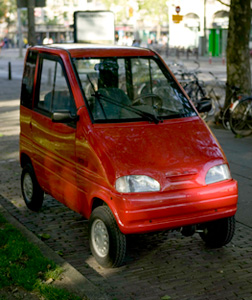The basic concept is that rather than trying to expand road infrastructure to meet traffic demand—a fiscal impossibility in many places—we should instead look for smaller vehicles that can more efficiently use the existing space. Hence the Tango, a twin-forklift-motor-powered micro-car that boasts fuel efficiency of 100 mpg, a roll-cage for safety, fans like George Clooney, and a host of potential benefits advertised in the submission: everything from increasing road and parking capacity to increasing suburban property values as commute times go down.
2. Smart Buses
As mchmiel argues, "If elevators can be smart when there isn't any human driving them, why can't buses be smart?" In fact, buses are getting smarter all the time, with computerized bus dispatch systems, which give passengers real-time bus location and arrival information, now in play in many cities. But mchmiel has something more far-reaching in mind: "Here's the solution: A city is broken up into a series of sectors and sub-sectors. Each sector has its own mini-fleet of public taxis, vans, and minibuses. Those buses move about in a flexible current that can respond in real time to user demand. Bus stops in each sector will be equipped with call boxes that can determine urgency and need. The route a driver takes to make it to the targeted bus stop is up to the driver—if traffic is preventing one way, then he can take an alternate route to get there as fast as possible. An organized dispatch prevents 'leap-frogging' buses from over-responding to stops."
3. Build a Better Bike Network
(B)icycles are one of the best solutions to the "problem of the first and last mile—the distance from homes to public transit that keeps people driving and (expensively) parking their cars rather than taking the bus or train."
Thankfully, there's a solution, one that is already being deployed in U.S. cities (and which has been written about in this column): the bike transit center. "These centers," Izzy notes, "also include amenities like lockers, showers, restrooms, bike repair and rental, and accessory retail, making it convenient and feasible to ride a bike for transportation. Bike transit centers placed near public transportation stations become a network, allowing people to ride a bike from home to the train station, park it securely, hop on the train, and rent or share a bike or electric vehicle at the other end of the line to get to work."
Read full story


No comments:
Post a Comment